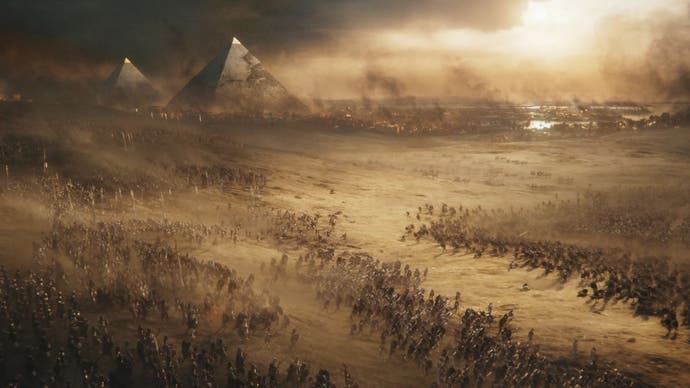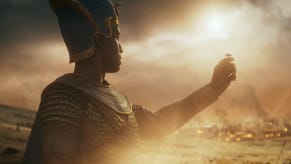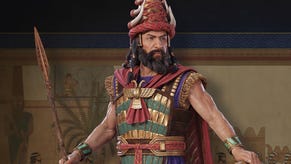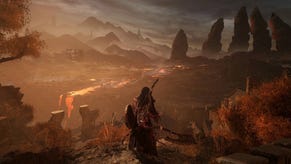Total War: Pharaoh takes the series back to vanilla history
Anubis of info to share.
It's some time in the 1200s BCE, a big wooden horse and/or earthquake is cracking open the gates of Troy and a thousand ships are crossing the Aegean - and, about 1500 kilometres away, another legendary ancient civilisation is on the edge of crumbling, too. While Ancient Greece was in full Odyssey mode, Ancient Egypt was heading towards the collapse of its New Kingdom, and with it the Bronze Age.
This is the realm of Total War: Pharaoh, the follow-up from the Total War: Troy studio, which Creative Assembly Sofia announced just last month with a release window of some time later in 2023. Here's the setup: old boy Pharaoh Menerptah's grip on his rule is weakening. New challengers are jostling for power. Plus the Sea Peoples are attacking in waves, law and order's breaking down, and the weather's getting a bit funky, too.
Why Egypt? As director Todor Nikolov put it to me, "because Egypt is quite popular, and was never represented in a Total War title." Usually Egypt was shown in the middle or later historical periods, he explained, such as the Ptolemaic era where "Greeks were all over Egypt" already. The Bronze Age was chosen this time because, "first of all, by that time, it's the New Kingdom of Egypt, and it has grown to be an empire that extends far away from the banks of the Nile."
"In distant lands, in addition to that there are other great empires like the Hittite Empire… and the late Bronze Age also ended with a collapse. That was a violent period where, you know, there were civil wars and external invaders and disasters and whatnot… the very setting is quite fitting for the purposes of a Total War title. You need an arena where a conflict can take place."
You'll play out this generally cataclysmic - but unlike Troy, decidedly non-mythical - scenario across three regions in Total War: Pharaoh. These are Ancient Egypt in the south, Canaan in the mid-east, and Anatolia in the north, with the Egyptians, Canaanites, and aforementioned Hittites making up the game's three factions, with a total of eight playable faction leaders across the trio. Coincidentally, it actually forms a remarkably similar idea to two concepts and their comments that popped up on the Total War subreddit just a couple of months ago, alongside mockups of delightfully weird mythical units for "Egypt" and "Mesopotamia" versions - although Nikolov and battle designer Bozhidar Staykov joked that they honestly hadn't seen those.
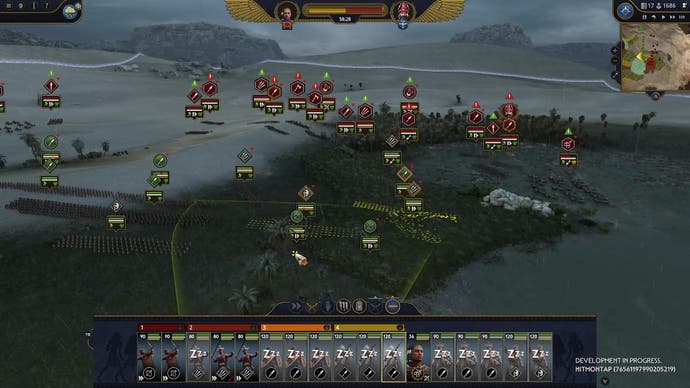

These regions will come together on a campaign map that Nikolov reckons is about "one third" larger than the Total War: Troy one, covering the area between "modern Sudan in the south, and Turkey in the north, in Anatolia," albeit with fewer, more spread out settlements, a direct response to feedback from Troy players. "There are 180 settlements or so," Nikolov told me, and confirmed that agents and heroes won't return to the campaign. "We're relying on general characters, but we're giving them some new exciting things they can do under certain circumstances to replace the agents."
As for the real-time battles, I played Total War: Pharaoh for a good few hours, getting some time with three specific scenarios all with Ramesses the soon-to-be-third as my commander, but against a few different enemies. The first, against the aggressive, expansionist Seti, a rival faction leader of some fellow Egyptians, was the easiest and smallest scale. The Egyptians in Total War: Pharoah are all about light armour, ranged units, and chariots, designed for quick hit-and-run harassment tactics and manoeuvrability, much the same as they have been when popping up in other Total War games, and this first battle was more or less a case of lining my units up along a big hill and letting them defend, but it made for a good showcase of one of the new battle mechanics.
Units now have up to three stances they can adopt: advance, hold (or shield/spear wall for those that have them), and fall back. They make use of some fancy new animations, something the Sofia studio again added after specific user feedback from Troy, which requested bespoke matched combat animations like the series has had reserved for special general units until now - something Nikolov described as "quite costly" in terms of development. These animations have knock-on effects for battles - more on that later - but beyond the visual impact, the stances they allowed are also of genuine tactical use: shield walls along hills and choke points are always satisfying, but the advance and fall back ones feel genuinely new, asking your units to gradually push forwards in an attempt to displace enemy defences, or slowly cede ground while staying in formation - and without actively turning and fleeing, thus avoiding as many losses as possible.
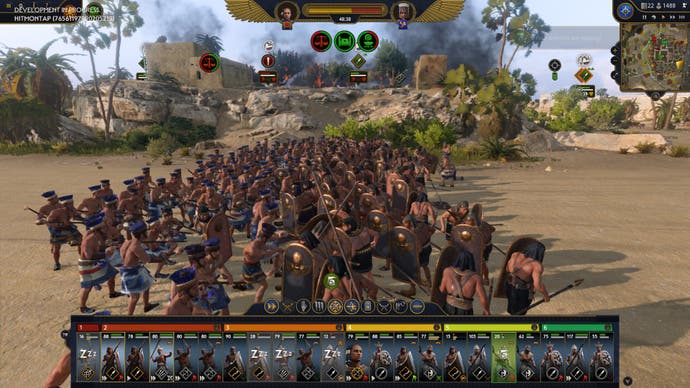
The second slightly more involved battle played out against Suppiluliuma of the Hittites, who're pitched in Total War: Pharaoh as the heavies of the region, "metallurgy experts" who have a range of armoured units that are strong in head to head combat but poor at manoeuvring. This took place on a map with a nice big pool of shallow water and mud, where it was strongly suggested we lure our opponent (and which worked pretty well: heavily armoured units are dramatically slowed in water and mud, making them more vulnerable for ranged attacks or faster flanking around their edges).
Third was the most challenging and most interesting battle, a later-game siege defence setup where Mennefer, the Egyptian capital, is under attack by the Sea Peoples, complete with some dramatic architecture and frankly enormous Great Pyramids on the horizon. Units were spread a little thin, but last-minute spear walls just in front of gates proved extremely effective for stalling rams, while ranged chariots distracted a few units at weaker areas for long enough to shuffle some heavy units across the city. This one took advantage of Pharaoh's reworked victory point system, with three separate, recapturable points prominently highlighted in the UI, and a newly heightened emphasis on burning down settlement buildings for expensive campaign map-layer damage, adding some pleasingly geekish realism value.
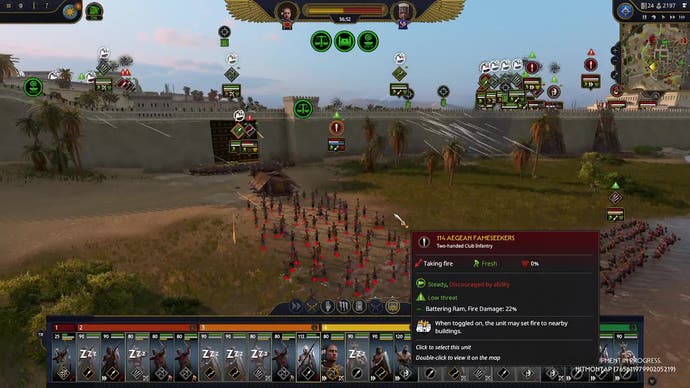
All three of these, you might be thinking, sound like pretty vanilla historical Total War battles - frankly, they are. There are small system additions, like those stances and a new stat for armour degradation, which proves especially decisive against certain units, but the big twist this time comes in the form of weather and fire, rather than any mythological, or even mythically-inspired units or features.
For some this shift in focus will be a blessing - Total War is nothing if not for its history nerds, and the grounded approach adds an actually quite refreshingly common sense feel in practice - but on first impressions here Pharaoh may also feel just the tiniest bit flat to those accustomed to the spice of special active abilities or even just big dudes with bull horns on their head calling themself a minotaur. The weather systems are fun, though, and undoubtedly new-feeling - dynamic weather now shifts during battles themselves, to new situations like thunderstorms, sandstorms, and sweltering heat - and they all combine nicely with other systems. Thunder and heavy rain reduces projectile effectiveness, turns dry land to mud, prevents fires, and makes troops a little nervy, for instance, while fog and sandstorms block vision, the latter also dealing tiny amounts of damage over time to all units and slowing stamina recovery. Sweltering heat makes fire spread faster - as does wind, which directly impacts its direction as it spreads from grass to trees to buildings - and naturally turns mud back to dry land and makes everyone knackered faster, too.
As Staykov explained to me, this was implemented to "increase the level of dynamism in the whole game. So we have fire on one hand, and now we have weather on the other hand, how can we make it more interesting?"
"So let's say if the battle starts with dry weather, no sun, clouds, it's looking good. You have your dry patch of land that you want to traverse through - and then the weather changes to a thunderstorm and it starts raining. That patch will become mud now, and you have to adapt to that new terrain, so let's say you want to charge your heavy chariots through that, that space. Now, they will bog down and most likely be killed off. And now you have to adapt."
Nikolov gave a similar example: let's say you want to take out an army with ranged superiority - "you might want to make sure that there is going to be a sandstorm during the battle, because sandstorms severely penalise those ranged units - not only by a percentage to their range or damage or whatever. Their projectiles are physically more inaccurate and they'll be moved away by the wind."
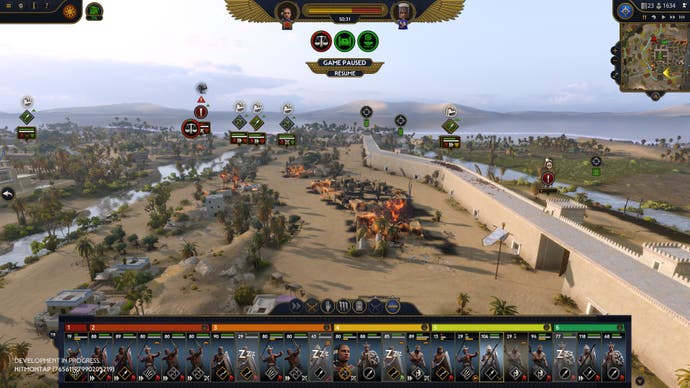
Maybe the most notable shift for the hardcore players, meanwhile, will be a change in battle pacing. Battles are now noticeably slower, with less micromanagement required and far less emphasis on perfectly-timed active abilities. The aim is for the player to make "fewer decisions, but more impactful ones… we want the player to experience the feel of a classic Total War title with a modern twist," Nikolov said. It also comes as a result of that shift in animations, Nikolov explained, which in turn made the battles play out "quite a lot slower."
To other fans, it'll be the return to realism that stands out. "For Troy," Nikolov explained, "we opted to go for the truth behind the myth design philosophy because the sources enabled us to do so. We had the Iliad and the entire epic cycle of Homer and other authors, and it was in a unique position where in these sources, history and mythology go hand in hand."
"For Pharaoh, it's quite different because we don't have those kinds of sources, we have historical data and archaeological data, and a lot of extrapolation in some cases… but what we are doing is [aiming] for historically authentic recreation of the Bronze Age world. Which means we are portraying the game in order for it to be easily recognisable to the players, and they could immediately tell that yes, this is Ancient Egypt, there are pyramids, there is the Nile."
The result of all this at the moment, with Total War: Pharaoh, is a game that feels a bit more considered, and also a little understated compared to recent Total Wars. This is a straight shot of Ancient Egyptian history, with a few creative liberties taken where the data leaves some gaps. It might seem a little low-key, but after years of bombastic, thrash metal fantasy and hybrid, interpretive mixes of history and ancient poetry, Pharaoh might scratch exactly the right kind of historical itch.
